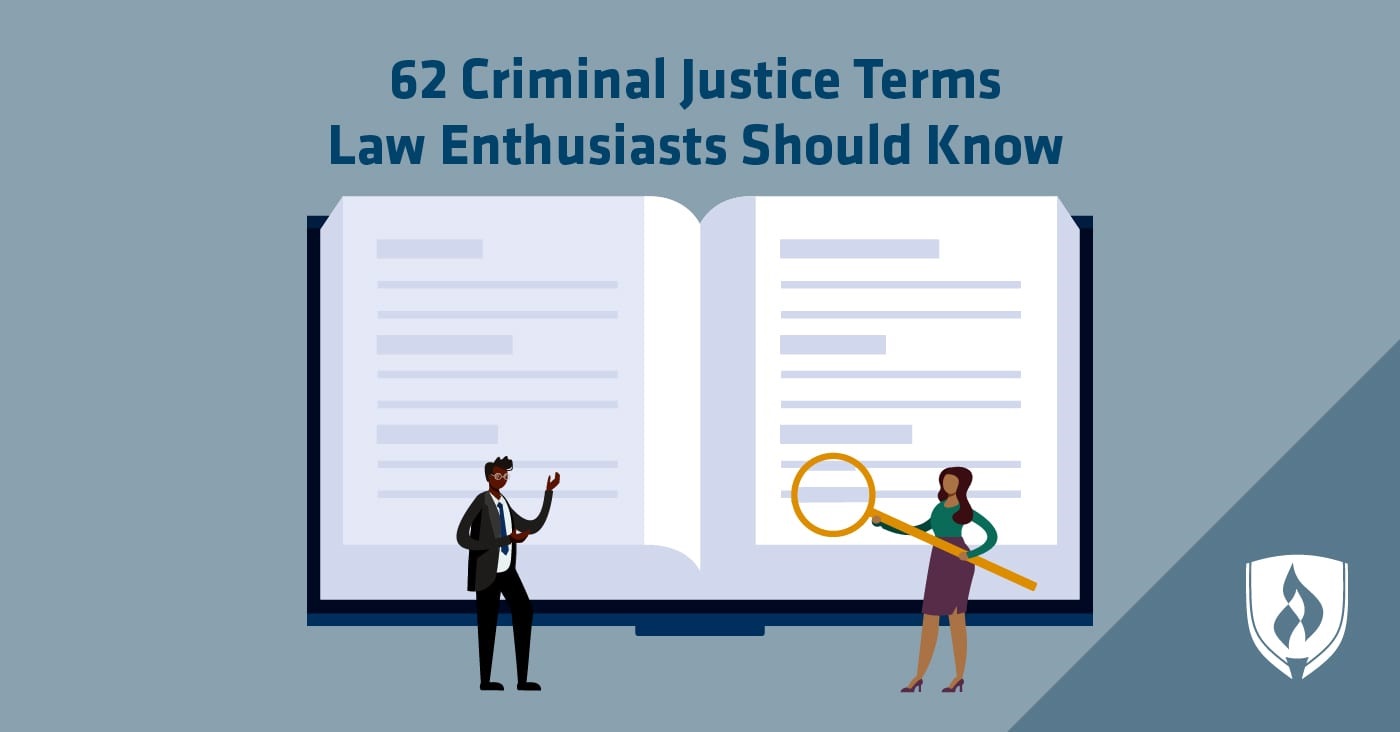
There is no getting around the fact that criminal justice is a fascinating field. It explores the outliers in society, the extremes, the repercussions of injustice. If you have a mild addiction to Law and Order, an interest in true crime, or even stay up to date on the news, you’re probably familiar with terms like habeas corpus, subpoena, grand jury, or probation—but might not have a great grasp on what they actually mean.
To help you get up to speed, we’ve compiled a list of common criminal justice terms that will help you navigate both your latest podcast obsession and the latest discussion on the future of policing.
Please note that these are pared down layman’s definitions of sometimes complex legal terms—some of which may have additional layers of complexity depending on state or local laws. This reference is intended to be a simplified primer and starting point for further learning.
With that out of the way, let’s get right into it.
Criminal Justice terms related to law enforcement:
1. Arrest
This refers to the process of taking a person into the custody (or control) of the legal system because they have been observed, confessed to, or suspected of committing a crime.
2. Combined DNA Index System (CODIS)
The Federal Bureau of Investigation’s database of DNA. CODIS is made up of 3 levels of information: Local DNA Index Systems, where DNA profiles are located; State DNA Index Systems, for labs within states to share information; and National DNA Index System, where states are able to compare DNA information. Contrary to what you might see on TV shows, CODIS itself does not contain any identifying information linked to DNA profiles. When a sample matches another sample in CODIS, the lab which originally uploaded the matching sample is notified and information is shared based upon the local laws governing that laboratory.
3. Cause of Death (COD)
Official description of how an individual physically died, for example, gunshot wound. This is typically determined by trained medical examiners.
4. Community policing
A philosophy of public safety that seeks to break down a distinction between the community and law enforcement so there is mutual trust, understanding and shared goals. Rather than a centralized police system entering into different communities they may have no ties to, community policing theorizes that law enforcement is more effective at promoting public safety when the individuals working in law enforcement are considered part of the communities they serve.
5. Crime
A term used to refer to acts a state or authority has decided are not permitted. Some interpretations argue against using the term “crime” to refer to consensual illegal activities like drug use.
6. Deoxyribonucleic Acid (DNA)
DNA is a molecule that forms a double helix of unique genetic information found in almost every cell in humans and most other organisms. DNA is essentially a blueprint for an organism to build and maintain itself through a fascinating process essential for life. DNA is useful in law enforcement because it is like a fingerprint, unique and identifiable, but present in almost every cell in a human body such as those in a drop of blood, a fingernail clipping, or saliva.
7. Excessive use of force
The use of physical force by law enforcement that goes beyond what is deemed necessary to protect public safety. What counts as “excessive” will vary greatly depending on specific contexts.
8. False arrest
Arrest of a person without probable cause or an order from a competent court.
9. Geo-fence warrant
A search warrant that allows law enforcement to locate all active mobile devices within a “geo-fence” (a virtual geographic perimeter).
10. Homicide
Killing of a human by another human—this act does not have to be intentional.
11. Manner of death (MOD)
The circumstances around a person’s death, such as “natural,” “accident,” “homicide” etc.
12. Missing person
A person whose fate (alive or dead) and location cannot be determined.
13. Scanning, Analysis, Response, and Assessment (SARA)
A simple method of problem solving used for “problem-oriented policing,” a philosophy of law enforcement developed in the 1980s. Problem-oriented policing placed an emphasis on research and crime prevention to reduce community problems.
14. Warrant
A document that is essentially an authorization for law enforcement to take an action such as a search or an arrest. A warrant typically requires sign-off from a judge who is presented with a rationale for why it is necessary.
Criminal Justice terms related to the court system:
15. Acquittal
A judgment of not guilty, or to put it more technically, when a defendant has been proven not guilty beyond a reasonable doubt.
16. Affidavit
A document of true facts. The person/party who writes the affidavit must make an oath that it is all true and then have the document notarized by an officer of court. Intentionally misleading or lying in a sworn affidavit is a form of perjury, a criminal offense.
17. Allegation
Something a person or party says occurred. An allegation is not necessarily verified or confirmed.
18. Appeal
After a trial has occurred, an appeal is the process of asking another court to decide if the trial was conducted properly. Grounds for appeal can include mishandling of evidence, ineffective counsel, jury misconduct, or prosecutorial misconduct—to name a few.
19. Arraignment
The process of being brought into a court of law following arrest, being told charges, and pleading guilty or not guilty to those charges.
20. Bail
Usually a sum of money given to the court in exchange for a person’s release from custody as a guarantee that they will return to court on an appointed time and date. For serious offenders or for those who may be likely flee the jurisdiction, a judge may opt to withhold bail.
21. Bench trial
A trial where a judge, not a jury, weighs the facts of a case and makes a ruling.
22. Beyond a reasonable doubt
This term refers to the necessary standard prosecutors must meet to convict a person of a crime. This high standard of guilt comes from a principal of the American justice system that a person is considered innocent until proven guilty.
23. Binding precedent
The decision a court has previously come to that must be followed by another court. You’ll often see references to this in cases that appear before the Supreme Court—they have the power to set new precedents.
24. Brief
A written statement given to a judge arguing for a particular verdict or decision.
25. Case law
How pervious court decisions determine the application of a law in a particular situation.
26. Chambers
The judge’s office. Representatives of both sides of a case may be called to meet here in private to discuss elements of a case that may influence the fairness of a trial proceeding, or just to simply discuss the logistics of a trial.
27. Circumstantial evidence
Any evidence that requires analysis to interpret as opposed to direct evidence. For example, circumstantial evidence would be a witness seeing a person fleeing the scene of a crime which leads them to believe the person was involved with the crime, and direct evidence would be a witness seeing a person commit a crime.
28. Conviction
A guilty judgment or verdict.
29. Counsel
Legal advice—can also refer to the individual or firm providing it.
30. Damages
Money paid by a defendant to a plaintiff to compensate for injuries—and that’s not just physical injuries.
31. Default judgment
If a defendant fails to appear in court, they may receive a default judgment against them.
32. Discovery
A lawyer’s examination of an opponent’s facts and documents in the preparation of a trial.
33. Docket
An official log of court proceedings.
34. Felony
A serious crime that’s accompanied by a penalty of at least one year in prison, typically reserved for major offenses like murder, drug trafficking or fraud involving large sums of money.
35. Grand jury
A body of citizens presented with evidence of criminal allegations who decide whether there is probable cause that an offence was committed. The federal government, not states, is required to use a grand jury.
36. Habeas corpus
Essentially, habeas corpus protects people from wrongful imprisonment or detention without trial. In the American justice system, there are limitations to habeas corpus that do allow for imprisonment without charges in some circumstances.
37. Hearsay
Testimony in court that refers to a statement made outside of court.
38. Inculpatory evidence
Evidence used to establish guilt—if you’re culpable, you’re responsible for something. Exculpatory evidence refers to evidence used to establish innocence.
39. Injunction
A legally binding order from a court that a person is required to do, or not do, a specific act.
40. Jurisdiction
A court or governmental agency’s authority over a situation; can also refer to the geographic area the court or government agency presides over.
41. Misdemeanor
In contrast to a felony, a misdemeanor refers to offenses that carry a penalty of less than a year in prison. Generally reserved for less-serious offenses like petty theft, aggravated assault, reckless driving, etc.
42. Mistrial
A trail that is made inconclusive or invalid. This can happen if a jury cannot come to an agreement on a verdict, or if a serious error was made during the trial proceedings.
43. Nolo contendere
Latin for “I do not wish to contend.” A plea typically used in misdemeanor cases where the defendant does not accept or deny responsibility for what they’ve been charged with, but agrees to accept the punishment. It might seem strange, but by pleading nolo contedere or no contest in a criminal trial, the defendant is able to avoid having a guilty plea used against them in later civil or criminal proceedings.
44. Petit jury
A trial jury that hears evidence and gives a verdict—usually a smaller number of people than what you’d find in a grand jury.
45. Plea
A defendant’s statement regarding their innocence or guilt.
46. Pro se
Latin phrase meaning “for oneself.” In the courtroom, that refers to when a defendant chooses to represent themselves instead of opting for an attorney.
47. Remand
Meaning “to send back.” Often used in bail hearings—a judge may choose to remand the accused back into custody if they’re a flight risk or a danger to the community. This term also appears when discussing legal appeals—an appeals court can remand a case back to a lower court in some circumstances.
48. Subpoena
The process of legally compelling a witness to appear in court or give testimony. Those who refuse to comply may be held in contempt of court with penalties ranging from fines to jail time.
49. Voir dire
A French term roughly translated to “to tell the truth.” In the U.S. legal system, this also refers to the jury selection process and the questioning of expert witness credentials.
Criminal Justice terms related to the correctional System:
50. Absconder
A parolee whose whereabouts are unknown.
51. Administrative detention
Broadly, the detention of a person without a trial. Within the prison system, administrative detention also refers to holding a person within solitary confinement or in other ways removing them from the general population within a prison.
52. Adult Internal Management System (AIMS)
Identification and separation of inmates into homogenous living groups to reduce tension, violence, victimization, and disruption.
53. Community Transition Program (CTP)
Programs to help formerly incarcerated people transition out of incarceration with supervision.
54. Conditions of confinement
Guided by the Eighth and Fourteenth Amendments, prison officials must provide humane conditions of confinement including adequate food, clothing, shelter, sanitation, medical care, and more within a prison or jail setting.
55. Conditional release
Release of a person from incarceration due to parole or suspended sentence.
56. Contraband
Items prohibited within a prison or jail facility.
57. Dead time
Time spent institutionalized that does not count towards a prison sentence—for example time spent confined in a mental hospital.
58. Furlough
A period of time when a person is released temporarily from incarceration.
59. Neglect
Insufficient care given to an incarcerated person resulting in their injury or death.
60. Parole
Release from incarceration to supervision within the community contingent on certain conditions, which, if violated, result in reincarceration.
61. Probation
A sentence given to a person instead of incarceration. Typically probation will come with terms like regular check-ins or drug testing. Violators of probationary terms may face additional penalties.
62. Re-entry program
Program for individuals at high risk of reoffending to help with a successful reintegration to the community outside of incarceration.
Ready to put these terms to use?
If you are ready to add these words to your vocabulary, you might want to consider a career in criminal justice. Criminal justice is a fulfilling and challenging career path that isn’t right for just anyone. Ask yourself if you might thrive in this unique and rewarding field with our article, “7 Signs You Should Consider a Career in Criminal Justice.”
Related Articles:




